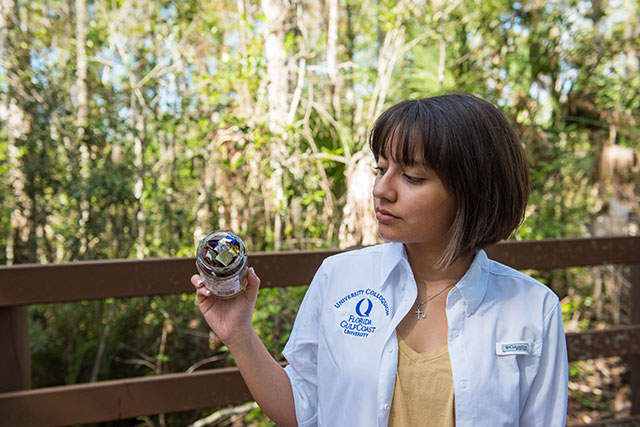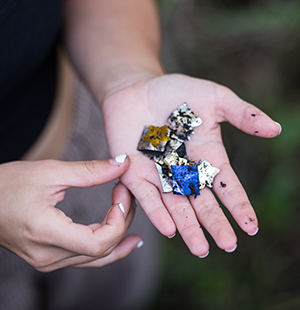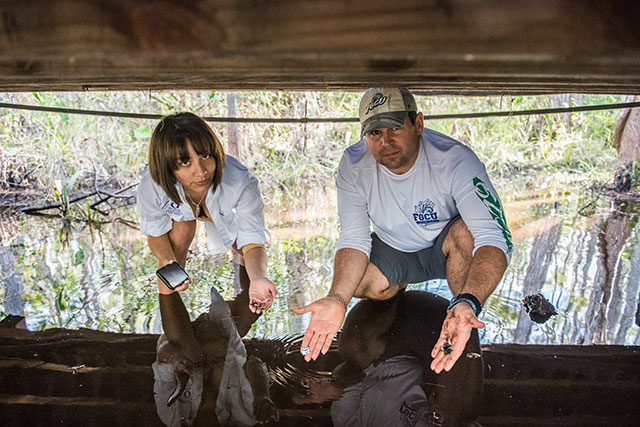Here’s a startling fact that might take a little luster off that graduation photo you might be planning in cap and gown while celebrating on a Florida Gulf Coast University boardwalk, immersed in a colorful explosion of glitter:
Every piece of glitter that has been tossed or blown skyward in pursuit of the perfect celebration picture — most definitely millions, more likely billions of shiny microplastic pieces smaller than 5 millimeters — still sits in the bowels of our 800-acre campus.

It will never decompose, at least not in the lifetime of anyone reading this. Time will only bury it deeper into the spots that make for scenic backdrops among the 324 acres of restored wetlands, 23 acres of created wetlands and 121 acres of upland preserve that we collectively and proudly advertise as a hallmark of our environmentally dedicated university.
“The volume of glitter under the boardwalk is hard to imagine unless you see it for yourself,” said Chad Evers, an instructor in the Department of Ecology & Environmental Studies and a member of the Sustainability and Resiliency Council. “Most of the surface of the soil is covered in glitter, and it can be found at least three inches down into the soil,” he said. “It’s easy to find within 10 feet of the boardwalk, and we have found glitter on the surface at least 15 feet away from the boardwalk, and it can be found floating in the water.”

In other words, FGCU has a glitter problem. And we are not alone. Glitter has become a social- media sensation, fueled by photo-sharing websites such as Instagram and Pinterest. About 10,000 tons of the shiny stuff are produced each year, manufactured to bring extra shimmer to crafts, cosmetics, paint finishes and, of course, photos. Earlier this year, Seventeen magazine rated shooting off a glitter cannon as the No. 1 way to improve graduation pictures, followed by sprinkles of sparkles at No. 8. As the magazine put it, “Everything is better with glitter.”
Really? It depends how you define “better.”
To produce glitter, sheets of polyethylene terephthalate (PET) are backed with a layer of aluminum and cut into tiny pieces. The aluminum is not much harm to the environment, but scientists say the PET plastic could survive 1,000 years. There is no known way to separate, sift or recycle glitter, and wastewater systems can’t filter much of it out. Glitter and other microplastics contribute to the 150 million tons (and growing) of plastic that has collected in the world’s oceans — not to mention FGCU’s campus waterways. “(Assistant Professor) Molly Nation and her students have found the presence of microplastics in all campus water samples they have tested, including the Whitaker pond, library pond and North Lake, ” Evers said.

Evers first became aware of FGCU’s glitter issue at the end of the spring 2018 semester. “I was teaching a Saturday session of University Colloquium and was shocked when I walked down the Merwin Hall boardwalk and found it covered in glitter,” Evers said. “I also noticed the glitter blowing into the wetlands. Prior to this day, I didn’t even know glitter was used in graduation photos. I did a quick search of the FGCU geotag on Instagram and found countless images of students taking these types of photos in several locations on campus.”
Freelance photographer Fabiana Solano has seen plenty of them, too. A 2019 communication graduate now working on a master’s in public administration with a concentration in environmental policy and planning, she is upfront on her website: “I consider myself to be a sustainable person, therefore a sustainable photographer. That means that during my shoots, I will not use any materials or do anything that may harm the environment.”
A native of Venezuela whose family moved to Fort Lauderdale when she was 7, Solano, 21, who spent her undergraduate years as a highly visible Honors College student around campus working in projects with University Marketing & Communications, was connected with Evers as her supervisor on the anti-glitter project by the instructor in her own University Colloquium class, Jessica Marcolini. Count Solano among those FGCU students who consider their Colloquium experience — the class where she first truly realized that glitter “was not a good thing” — more than just enlightening.
“It changed my life … I can honestly say that,” she said. “I didn’t have a car then, and I would bike to classes all summer. I started changing how I ate, paid closer attention to everything I bought. I started being more intentional with everything I owned.”
Solano was the one who came up with the #DON’TgLITTER hashtag used to promote the message and mission, and along with Evers, she says there are other likeminded professors and students who are on board.
“We need to bring awareness … I’m very passionate about this,” she said. “I mean, I’ll see other photographers out there using glitter and ask them not to, but all they’ll say is that they do what the client wants. And don’t forget, some photographers don’t get it the first shot, so they use more glitter for more takes. I’ve even found bags of unused glitter just left behind.”

Solano points out that it isn’t just the boardwalks that are getting glittered, but other spots on campus such as the signature fountain outside Lutgert Hall and the lakefront beach at North Lake Village. “I’ve seen confetti just sticking out of the sand,” she said.
So what are the alternatives, given that graduation photos on campus are rites of passage that aren’t going away? Solano recommends using photo enhancers such as flower petals or bubbles, or maybe props that have personal meaning. And of course, there’s the natural look. “Our university is so beautiful already, there are so many scenic places you can use for background,” she said.
One alternative she won’t buy into is biodegradable glitter that breaks down in water. “There’s nothing to stop people from using plastic glitter and just saying it’s the biodegradable type,” Solano said. “Plus, when it’s in the water, it looks like sludge.”
Polluter’s denial when it comes to using glitter seems peculiar to both Solano and Evers, given that students are taught to practice environmental sensitivity and to promote a sustainable lifestyle throughout their FGCU experience.
“Here kids come to an environmental school, you think they’re ready to graduate and practice that lifestyle … and then this,” Solano said. “The thing is, kids don’t actually litter, but they use glitter. I mean, glitter is a plastic, but students don’t throw their Honey Bun wrapper over the boardwalk and that’s plastic. Students realize glitter is litter, but they don’t correlate the two.”
Evers knows that to be true. “The interesting thing is that besides the glitter, we found very little other forms of trash under the boardwalk,” he said. “Somewhere in student education there is a disconnect that students aren’t connecting that glitter is litter.
“I believe that many environmental issues are issues because most people don’t know that they are issues,” Evers said. “Environmental education is more important now than ever. When students know better, they can do better.”